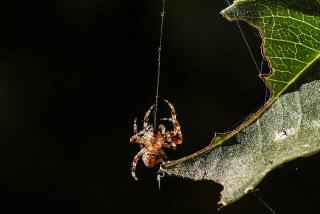Painted Ladies Are Leaving Their Mark
RIVERSIDE — An airborne paradox, the Painted Lady.
So elegant in life.
So undignified in death.
Some inland and desert stretches of Southern California have been overrun in recent days by millions of Painted Lady butterflies, which are eating the bumper crop of thistles, fiddlenecks and other wildflowers that are a legacy of heavy winter rains.
The black, brown and orange butterflies are expected to soar through Central and Northern California in the next month or so, then into Oregon and possibly southwest Canada before petering out for the year.
It is not simply the appearance of the butterflies that is so unusual--Painted Ladies migrate north from Mexico each spring and have a modest increase every five years or so.
But the size of this year’s migration has the inland region abuzz.
By some estimates--though no one knows for sure--as many as a billion Painted Ladies, also known as Cosmopolitans, have been winging through Southern California for the last week. Greg Ballmer, an entomologist at UC Riverside, said there is a Painted Lady caterpillar for every square meter of the Mojave Desert these days.
Their exodus is delighting entomologists. Butterfly nets are selling like Hula Hoops.
But not everyone is taking the invasion so kindly. Virtually every car traveling through eastern stretches of Riverside and San Bernardino counties these days carries yellowish-green stripes.
“Guts,” said Carol Sowders, a cashier at a Redlands carwash, where workers are using a cleaner called Bug Juice by the gallon. “It’s just a joy. This is the worst I’ve seen it for quite some time.”
Still it’s a very natural process, scientists say.
Heavy rains in January and February left an unusually thick batch of wildflowers this spring, first in northern Mexico, where the caterpillars began their voyage, and now in the inland valleys of California.
“It’s a really good year for their host plant,” said Dave Hawks, a UC Riverside entomologist. “So the populations of the butterflies have just been exploding.”
Even the windshield stains are natural. It’s fat--the butterfly’s equivalent of a bear storing up enough energy to make it through the winter.
“These migrating butterflies have a large amount of stored fat,” Ballmer said. “That’s what they feed off when they are flying. And that’s why they make such a mess.”



